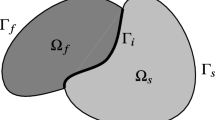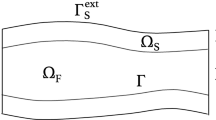Abstract
In this work we consider the fluid-structure interaction in fully nonlinear setting, where different space discretization can be used. The model problem considers finite elements for structure and finite volume for fluid. The computations for such interaction problem are performed by implicit schemes, and the partitioned algorithm separating fluid from structural iterations. The formal proof is given to find the condition for convergence of this iterative procedure in the fully nonlinear setting. Several validation examples are shown to confirm the proposed convergence criteria of partitioned algorithm. The proposed strategy provides a very suitable basics for code-coupling implementation as discussed in Part II.
Similar content being viewed by others
References
Arnold M (2001) Constraint partitioning in dynamic iteration methods. Z Angew Math Mech 81: 735–738
Arnold M, Gunther M (2001) Preconditioned dynamic iteration for coupled differential-algebraic systems. BIT Numer Math 41: 1–25
Barcelos M, Bavestrello H, Maute K (2006) A Schur–Newton–Krylov solver for steady-state aeroelastic analysis and design sensitivity analysis. Comput Methods Appl Mech Eng 195: 2050–2069
Bathe K-J, Zhang H (2009) A mesh adaptivity procedure for CFD and fluid-structure interactions. Comput Struct 87(11–12): 604–617
Bazilevs Y, Calo VM, Hughes TJR, Zhang Y (2008) Isogeometric fluid-stucture interaction: theory, algorithms and computations. Comput Mech 43: 3–37
Bazilevs Y, Calo VM, Zhang Y, Hughes TJR (2006) Isogeometric fluid-structure interaction analysis with applications to arterial blood flow. Comput Mech 38: 310–322
Bazilevs Y, Gohean JR, Hughes TJR, Moser RD, Zhang Y (2009) Patient-specific isogeometric fluid-structure interaction analysis of thoraci aortic blood flow due to implation of the jarvik 2000 left ventricular assist device. Comput Methods Appl Mech Eng 198: 3534–3550
Bazilevs Y, Hsu M-C, Benson D, Sankaran S, Marsden A (2009) Computational fluid-structure interaction: methods and application to a total cavopulmonary connection. Comput Mech 45: 77–89
Bazilevs Y, Hsu M-C, Zhang Y, Kvamsdal T, Hentschel S, Isaksen J (2010) Computational fluid-structure interaction: methods and application to cerebral aneurysms. Biomech Model Mechanobiol 9: 481–498
Belytschko T, Yen HJ, Mullen R (1979) Mixed methods for time integration. Comput Methods Appl Mech Eng 17(18): 259–275
Belytschko T (1983) An overview of semidiscretization and time integration procedures. In: Belytschko T, Hughes TJR (eds) Computational methods for transient analysis. North-Holland, Amsterdam, pp 1–65
Belytschko T, Liu WK, Moran B (2000) Nonlinear finite elements for continua and structures. Wiley, New York
Brenan KE, Campbell SLV, Petzold LR (1996) Numerical solution of initial-value problems in differential-algebraic equations. Society for Industrial and Applied Mathematics, Philadelphia
Bruneau C-H, Saad M (2006) The 2D lid-driven cavity problem revisited. Comput Fluids 35: 326–348
Causin P, Gerbeau J-F, Nobile F (2005) Added-mass effect in the design of partitioned algorithms for fluid-structure problems. Comput Methods Appl Mech Eng 194(42–44): 4506–4527
Degroote J, Bathe K-J, Vierendeels J (2009) Performance of a new partitioned procedure versus a monolithic procedure in fluid-structure interaction. Comput Struct 87(11–12): 793–801
Demirdžić I, Perić M (1988) Space conservation law in finite volume calculations of fluid flow. Int J Numer Methods Fluids 8(9): 1037–1050
Deparis S, Discacciati M, Fourestey G, Quarteroni A (2006) Fluid-structure algorithms based on Steklov-Poincaré operators. Comput Methods Appl Mech Eng 195(41–43): 5797–5812
Dettmer WG, Perić D (2007) A fully implicit computational strategy for strongly coupled fluid-solid interaction. Arch Comput Methods Eng 14: 205–247
Deuflhard P, Hairer E, Zugck J (1987) One-step and extrapolation methods for differential-algebraic systems. Numer Math 51: 501–516
Farhat C, Lesoinne M (2000) Two efficient staggered algorithms for the serial and parallel solution of three-dimensional nonlinear transient aeroelastic problems. Comput Methods Appl Mech Eng 182: 499–515
Farhat C, Lesoinne M, Maman N (1995) Mixed explicit/implicit time integration of coupled aeroelastic problems: three-field formulation, geometric conservation and distributed solution. Int J Numer Methods Eng 21(10): 356–367
Felippa CA, Park KC (2004) Synthesis tools for structural dynamics and partitioned analysis of coupled systems. In: Ibrahimbegović A, Brank B (eds) NATO advanced research workshop. IOS Press, The Netherlands, pp 50–111
Felippa CA, Park KC, de Runtz JA (1977) Stabilization of staggered solution procedures for fluid-structure interaction analysis. In: Computational methods for fluid-structure interaction problems, pp 95–124
Fernández MÁ, Gerbeau J-F, Gloria A, Vidrascu M (2008) Domain decomposition based Newton methods for fluid-structure interaction problems. In: ESAIM: proceedings, vol 22, pp 67–82. http://edpsciences.org
Fernández MÁ, Moubachir M (2005) A Newton method using exact Jacobians for solving fluid–structure coupling. Comput Struct 83(2–3): 127–142
Ferziger JH, Perić M (2002) Computational methods for fluid dynamics, 3rd edn. Springler, Berlin
Förster C, Wall WA, Ramm E (2006) On the geometric conservation law in transient ow calculations on deforming domains. Int J Numer Methods Fluids 50: 1369–1379
Förster C, Wall WA, Ramm E (2007) Artificial added mass instabilities in sequential staggered coupling of nonlinear structures and incompressible viscous flows. Comput Methods Appl Mech Eng 196: 1278–1291
Franca LP, Hughes TJR, Stenberg R (1993) Stabilized finite element methods. In: Incompressible computational fluid dynamics, pp 87–107
Gerbeau JF, Vidrascu M (2003) A quasi-Newton algorithm based on a reduced model for fluid-structure interaction problems in blood flows. Math Model Numer Anal 37(4): 631–647
Ghia U, Ghia KN, Shin CT (1982) High-Re solutions for incompressible flow using the Navier-Stokes equations and a multigrid method. J Comput Phys 48: 387–411
Heil M (2004) An efficient solver for the fully coupled solution of large-displacement fluid–structure interaction problems. Comput Methods Appl Mech Eng 193(1–2): 1–23
Hortmann M, Perić M, Scheuerer G (1990) Finite volume multigrid prediction of laminar natural convection: bench-mark solutions. Int J Numer Methods Fluids 11: 189–207
Hübner B, Walhorn E, Dinkler D (2004) A monolithic approach to fluid-structure interaction using space-time finite elements. Comput Methods Appl Mech Eng 193: 2087–2104
Hughes TJR, Liu WK, Zimmermann TK (1981) Lagrangian-Eulerian finite element formulation from incompressible viscous flows. In: Interdisciplinary finite element analysis: proceedings of the US-Japan Seminar Held at Cornell University, p 179. College of Engineering and School of Civil and Environmental Engineering of Cornell University
Hughes TJR, Pister KS, Taylor RL (1979) Implicit-explicit finite elements in nonlinear transient analysis. Comput Methods Appl Mech Eng 17: 159–182
Hughes TJR, Franca LP, Balestra M (1986) A new finite element formulation for computational fluid dynamics: V. Circumventing the Babuška–Brezzi condition: A stable Petrov–Galerkin formulation of the Stokes problem accommodating equal-order interpolations. Comput Methods Appl Mech Eng 59: 85–99
Ibrahimbegovic A (2009) Nonlinear solid mechanics: theoretical formulations and finite element solution methods. Springer, Berlin
Ibrahimbegovic A, Brank B (2005) Engineering structures under extreme conditions: multi-physics and multi-scale computer models in non-linear analysis and optimal design. IOS Press, The Netherlands
Ibrahimbegovic Z, Mamouri S (2002) Energy conserving and decaying implicit time-stepping scheme for nonlinear dynamics of three-dimensional beams undergoing finite rotations. Comput Methods Appl Mech Eng 191: 4241–4258
Joosten M, Dettmer WG, Perić D (2009) Analysis of the block Gauss-Seidel solution procedure for a strongly coupled model problem with reference to fluid-structure interaction. Int J Numer Methods Eng 78(7): 757–778
Kassiotis C, Colliat J-B, Ibrahimbegovic A, Matthies HG (2009) Multiscale in time and stability analysis of operator split solution procedure applied to thermomechanical problems. Eng Comput 1–2: 205–223
Kassiotis C, Ibrahimbegovic A, Matthies HG, Brank B (2010) Stable splitting scheme for general form of associated plasticity including different scales of space and time. Comput Methods Appl Mech Eng 199: 1254–1264
Küttler U, Förster C, Wall WA (2006) A solution for the incompressibility dilemma in partitioned fluid-structure interaction with pure Dirichlet fluid domains. Comput Mech 38: 417–429
Küttler U, Wall WA (2008) Fixed-point fluid-structure interaction solvers with dynamic relaxation. Comput Mech 43(1): 61–72
Le Tallec P, Mouro J (2001) Fluid structure interaction with large structural displacements. Comput Methods Appl Mech Eng 190(24–25): 3039–3067
Legay A, Chessa J, Belytschko T (2006) An Eulerian-Lagrangian method for fluid-structure interaction based on level sets. Comput Methods Appl Mech Eng 195(17–18): 2070–2087
Matthies HG, Niekamp R, Steindorf J (2006) Algorithms for strong coupling procedures. Comput Methods Appl Mech Eng 195: 2028–2049
Matthies HG, Steindorf J (2003) Partitioned strong coupling algorithms for fluid-structure interaction. Comput Struct 81: 805–812
Mehl M, Brenk M, Bungartz HJ, Daubner K, Muntean IL, Neckel T (2008) An Eulerian approach for partitioned fluid-structure simulations on Cartesian grids. Comput Mech 43(1): 115–124
Mittal S, Tezduyar TE (1995) Parallel finite element simulation of 3D incompressible flows—fluid-structure interactions. Int J Numer Methods Fluids 21: 933–953
Mok DP, Wall WA, Ramm E (2001) Accelerated iterative substructuring schemes for instationnary fluid-structure interaction. In: First MIT conference computational fluid and solid mechanics. Elsevier, Amsterdam, pp 1325–1328
Oden JT, Belytschko T, Babuska I, Hughes TJR (2003) Research directions in computational mechanics. Comput Methods Appl Mech Eng 192(7–8): 913–922
OpenCFD LTD. Openfoam home page, 2000–2009. http://www.opencfd.co.uk/openfoam
Perić D, Dettmer WG, Saksono PH (2006) Modelling fluid-induced structural vibrations: reducing the structural risk for stormywinds. In: Ibrahimbegovic A (ed) NATO advanced research workshop, ARW 981641, Opatija, Croatia, pp 239–268
Piperno S, Farhat C (2001) Partitioned procedures for the transient solution of coupled aeroelastic problems–Part II: energy transfer analysis and three-dimensional applications. Comput Methods Appl Mech Eng 190: 3147–3170
Roshko A (1952) Of the development of turbulent wakes from vortex streets. Ph.D. thesis, California Institute of Technology, Pasadena, CA
Ross MR, Sprague MA, Felippa CA, Park KC (2009) Treatment of acoustic fluid-structure interaction by localized Lagrange multipliers and comparison to alternative interface-coupling methods. Comput Methods Appl Mech Eng 198(9–12): 986–1005
Schäfer M, Turek S (1996) Benchmark computations of laminar flow around a cylinder. Notes Numer Fluid Mech 52: 547–566
Takizawa K, Moorman C, Wright S, Christopher J, Tezduyar T (2010) Wall shear stress calculations in space-time finite element computation of arterial fluid structure interactions. Comput Mech 46(1): 31–41
Tezduyar T, Takizawa K, Moorman C, Wright S, Christopher J (2010) Multiscale sequentially-coupled arterial FSI technique. Comput Mech 46(1): 17–29
Tezduyar TE, Mittal S, Ray SE, Shih R (1992) Incompressible flow computations with stabilized bilinear and linear equal-order interpolation velocity-pressure elements. Comput Methods Appl Mech Eng 95: 221–242
Tezduyar TE, Sathe S, Keedy R, Stein K (2006) Space–time finite element techniques for computation of fluid–structure interactions. Comput Methods Appl Mech Eng 195(17–18): 2002–2027
Tezduyar TE, Sathe S, Pausewang J, Schwaab M, Christopher J, Crabtree J (2008) Interface projection techniques for fluid–structure interaction modeling with moving-mesh methods. Comput Mech 43(1): 39–49
Turek S, Hron J (2006) Proposal for numerical benchmarking of fluid-structure interaction between an elastic object and laminar incompressible flow. Lect Notes Comput Sci Eng 53: 371
Wall WA, Mok DP, Ramm E (1999) Partitioned analysis approach of the transient coupled response of viscous fluids and flexible structures. In: Solids, structures and coupled problems in engineering, proceedings of the European conference on computational mechanics
Wall WA, Ramm E (1998) Fluid-structure interaction based upon a stabilized (ALE) finite element method. Sonderforschungsbereich 404, Institut für Baustatik und Baudynamik, Germany
Wang H, Belytschko T (2009) Fluid-structure interaction by the discontinuous-Galerkin method for large deformations. Int J Numer Methods Eng 77(1): 30–49
Zienkiewicz OC, Taylor RL (2001) The finite element method, solid mechanics, vol 2, 5th edn. Butterworth Heinemann, Oxford
Zienkiewicz OC, Taylor RL (2001) The finite element method, the basis, vol 1, 5th edn. Butterworth Heinemann, Oxford
Author information
Authors and Affiliations
Corresponding author
Rights and permissions
About this article
Cite this article
Kassiotis, C., Ibrahimbegovic, A., Niekamp, R. et al. Nonlinear fluid–structure interaction problem. Part I: implicit partitioned algorithm, nonlinear stability proof and validation examples. Comput Mech 47, 305–323 (2011). https://doi.org/10.1007/s00466-010-0545-6
Received:
Accepted:
Published:
Issue Date:
DOI: https://doi.org/10.1007/s00466-010-0545-6




